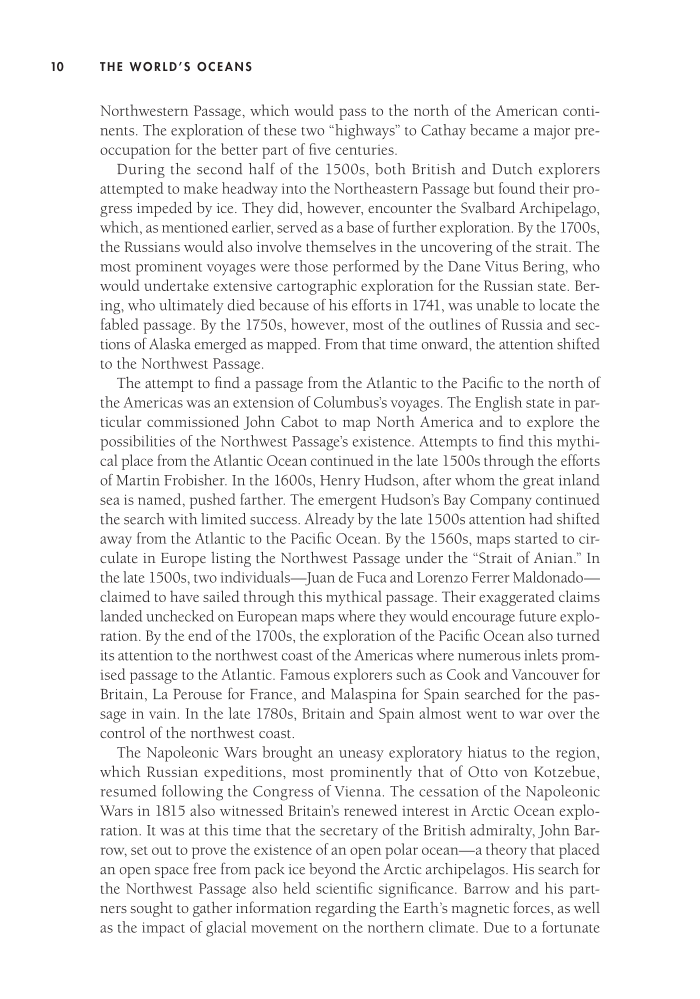10 THE WORLD’S OCEANS Northwestern Passage, which would pass to the north of the American conti- nents. The exploration of these two “highways” to Cathay became a major pre- occupation for the better part of five centuries. During the second half of the 1500s, both British and Dutch explorers attempted to make headway into the Northeastern Passage but found their pro gress impeded by ice. They did, however, encounter the Svalbard Archipelago, which, as mentioned earlier, served as a base of further exploration. By the 1700s, the Russians would also involve themselves in the uncovering of the strait. The most prominent voyages were those performed by the Dane Vitus Bering, who would undertake extensive cartographic exploration for the Russian state. Ber- ing, who ultimately died because of his efforts in 1741, was unable to locate the fabled passage. By the 1750s, however, most of the outlines of Russia and sec- tions of Alaska emerged as mapped. From that time onward, the attention shifted to the Northwest Passage. The attempt to find a passage from the Atlantic to the Pacific to the north of the Amer i cas was an extension of Columbus’s voyages. The English state in par ticular commissioned John Cabot to map North America and to explore the possibilities of the Northwest Passage’s existence. Attempts to find this mythi- cal place from the Atlantic Ocean continued in the late 1500s through the efforts of Martin Frobisher. In the 1600s, Henry Hudson, after whom the great inland sea is named, pushed farther. The emergent Hudson’s Bay Company continued the search with limited success. Already by the late 1500s attention had shifted away from the Atlantic to the Pacific Ocean. By the 1560s, maps started to cir- culate in Europe listing the Northwest Passage under the “Strait of Anian.” In the late 1500s, two individuals—Juan de Fuca and Lorenzo Ferrer Maldonado— claimed to have sailed through this mythical passage. Their exaggerated claims landed unchecked on Eu ro pean maps where they would encourage future explo- ration. By the end of the 1700s, the exploration of the Pacific Ocean also turned its attention to the northwest coast of the Amer i cas where numerous inlets prom- ised passage to the Atlantic. Famous explorers such as Cook and Vancouver for Britain, La Perouse for France, and Malaspina for Spain searched for the pas- sage in vain. In the late 1780s, Britain and Spain almost went to war over the control of the northwest coast. The Napoleonic Wars brought an uneasy exploratory hiatus to the region, which Russian expeditions, most prominently that of Otto von Kotzebue, resumed following the Congress of Vienna. The cessation of the Napoleonic Wars in 1815 also witnessed Britain’s renewed interest in Arctic Ocean explo- ration. It was at this time that the secretary of the British admiralty, John Bar- row, set out to prove the existence of an open polar ocean— a theory that placed an open space free from pack ice beyond the Arctic archipelagos. His search for the Northwest Passage also held scientific significance. Barrow and his part- ners sought to gather information regarding the Earth’s magnetic forces, as well as the impact of glacial movement on the northern climate. Due to a fortunate
Document Details My Account Print multiple pages
Print
You have printed 0 times in the last 24 hours.
Your print count will reset on at .
You may print 0 more time(s) before then.
You may print a maximum of 0 pages at a time.































































































































































































































































































































































































































































